![]()
![]()
![]()
Use LEFT and RIGHT arrow keys to navigate between flashcards;
Use UP and DOWN arrow keys to flip the card;
H to show hint;
A reads text to speech;
198 Cards in this Set
- Front
- Back
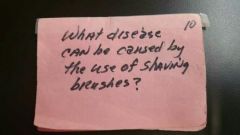
|

|
|

|

|
|
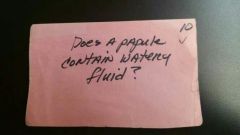
|

|
|
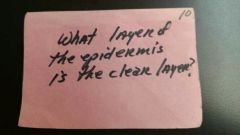
|

|
|

|

|
|

|

|
|

|

|
|
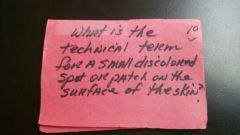
|

|
|
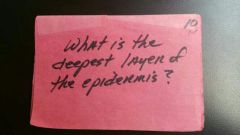
|

|
|

|

|
|
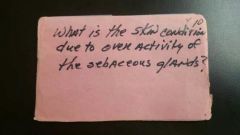
|

|
|

|

|
|

|

|
|

|

|
|

|

|
|
|
acne |
skin disorder characterized by chronic inflammation of the sebaceous glands from retained secretions |
|
|
also known as subcutaneous tissue; lots beneath the dermis |
adipose tissue |
|
|
congenital leukoderma or absence of melanin pigment in the body |
albinism |
|
|
deficiency or lack of perspiration |
anhidrosis |
|
|
inflammatory skin disease characterized by the presence of a small, red papule, followed by the formation of a pustule, vesicle, and hard swelling |
anthrax |
|
|
condition of dry, scaly skin due to lack of sebum |
asteatosis |
|
|
most common and least severe type of skin cancer |
Basal cell carcinoma |
|
|
an open comedone; consists of an accumulation of excess oil (sebum) that had been oxidized to a dark color |
blackhead |
|
|
foul smelling perspiration |
bromhidrosis |
|
|
a large blister containing a watery fluid |
bulla |
|
|
non-elevated spots due to increased pigmentation in the skin |
chloasma |
|
|
technical term for a scar |
cicatrix |
|
|
fibrous protein that gives the skin form and strength |
collagen |
|
|
a mass of hardened sebum and skin cells in a hair follicle that may be open (blackhead) or closed (white) |
comedones |
|
|
another name for the dermis |
corium |
|
|
dead cells that have accumulated over a wound |
crust or scab |
|
|
another name for epidermis |
cuticle |
|
|
another name for the dermis |
cutis |
|
|
a closed, abnormally developed sac containing fluid or morbid matter, above or below the skin |
cyst |
|
|
technical name for skin; also another name for dermis |
derma |
|
|
an inflammatory condition of the skin |
dermatitis |
|
|
an eruptive skin condition due to contact with irritating substances such as tints or chemicals |
dermatitis venenata |
|
|
medical science that deals with the study of the skin |
dermatology |
|
|
second or inner layer of the skin; also known as the derma, corium, cutis, or true skin |
dermis |
|
|
inflammatory skin condition characterized by painful itching; dry or moist lesion forms |
eczema |
|
|
protein base similar to collagen that forms elastic tissue |
elastin |
|
|
Outermost layer of the skin; also called the cuticle or scarf skin |
epidermis |
|
|
skin sore or abrasion caused by scratching or scraping |
excoriation |
|
|
a crack in the skin that penetrates to the dermis |
fissure |
|
|
fever blister or cold sore; a recurring viral infection |
herpes simplex |
|
|
excessive perspiration or sweating |
hyperhyrodis |
|
|
abnormal skin growth |
hypertrophy |
|
|
a skin inflammation caused by exposure to poison ivy; poison oak, or poison sumac |
ivy dermatitis |
|
|
a thick scar resulting from excessive tissue growth |
keloid |
|
|
technical name for a callus; caused by pressure or friction |
Keratoma |
|
|
technical name for freckles |
lentigines |
|
|
structural change in the tissues cause by injury or disease |
lesion |
|
|
skin disorder characterized by abnormal white patches |
leukoderma |
|
|
spot or discoloration of the skin such as a freckle |
macule |
|
|
most severe form of skin cancer |
malignant melanoma |
|
|
coloring matter or pigment of the skin; found in the stratum germinativum of the epidermis and in the papillary layers of the dermis |
melanin |
|
|
technical name for milk spots; small benign, whitish bumps that occur when dead skin is trapped in the surface of the skin, commonly seen in infants |
milia |
|
|
technical name for prickly heat |
miliaria rubra |
|
|
small brownish spot on the skin |
mole |
|
|
nerve fibers distributed to the arrector pili muscles, which are attached to the hair follicles |
motor nerve fibers |
|
|
technical name for a birthmark |
nevus |
|
|
outer layer of the dermis, directly beneath the epidermis |
papillary layer |
|
|
papule |
pimple |
|
|
skin disease characterized by red patches and silvery-white scales |
psoriasis |
|
|
inflamed pimple, containing pus |
pustule |
|
|
deeper layer of the dermis |
reticular layer |
|
|
chronic congestion of the skin characterized by redness, blood vessel dilation, papules, and pustules |
rosacea |
|
|
an accumulation of dry or greasy flakes on the skin |
scale |
|
|
another name for the epidermis |
scarf skin |
|
|
oil glands of the skin connected to hair follicles |
sebaceous glands |
|
|
skin condition caused by excessive sebum secretions |
seborrhea |
|
|
an oily substance secreted by the sebaceous glands |
sebum |
|
|
regulate the excretion of perspiration from the sweat glands and the flow of sebum from the oil glands |
secretory nerve fibers |
|
|
react to heat,cold, touch, pressure, and passion, and send messages to the brain |
sensory nerve fibers |
|
|
type of skin cancer more serious than basal cell carcinoma, but not as setups as malignant melonoma |
squamous cell carcinoma |
|
|
abnormal brown or wine-colored skin discoloration |
stain |
|
|
sebaceous cyst or fatty tumor |
steatoma |
|
|
outermost layer of the epidermis; the horny Layer |
stratum corneum |
|
|
innermost layer of the epidermis, also known ss the basal or Malpighian layer |
stratum germinativum |
|
|
granular layer of the epidermis beneath the stratum lucidum; the grainy layer |
stratum granulosum |
|
|
stratum lucidum |
clear layer of the epidermis, directly beneath the stratum corneum |
|
|
spiny layer of the epidermis, often considered part of the stratum germinativum |
stratum spinosm |
|
|
fatty tissue layer that lies beneath the dermis; also called adipose tissue |
subcutaneous tissue |
|
|
skin sweat glands |
sudoriferous glands |
|
|
signs of disease that can be felt (subjective) or seen (objective) |
symptoms |
|
|
darkening of the skin due to exposure to ultraviolet rays |
tan |
|
|
another name for the dermis |
true skin |
|
|
abnormal, solid lump above, within, or below the skin |
tubercule |
|
|
open skin lesion accompanied by pus and loss of skin depth; a deep erosion; a depression in the skin, normally due to infection or cancer |
ulcer |
|
|
technical name for a wart |
veruca |
|
|
small blister or sac containing clear fluid |
vesicle |
|
|
an acquired leukoderma characterized by milky-white spots |
vitiligo |
|
|
itchy, swollen lesion caused by insect bites or plant irritations, such as nettle |
wheal |
|
|
a closed comedone; consists of accumulated sebum that remains a whitish color because it does not have follicular opening for exposure to oxygen |
whitehead |
|
|
disease having a rapid onset, severe symptoms, and a short course or duration |
acute disease |
|
|
reaction to certain food, chemicals, or other normally harmless substances |
allergy |
|
|
disease of long duration, usually mild bit recurring |
chronic disease |
|
|
disease that exist at birth |
congenital |
|
|
disease that is communicable or transmittable by contact |
contagious disease |
|
|
any condition or disease that makes an indicated treatment or medication inadvisable |
contraindication |
|
|
Determination of the nature of a disease from its symptoms |
diagnosis |
|
|
abnormal condition of all or part of the body or mind that makes it incapable of carrying on normal function |
disease |
|
|
a disease that simultaneously attacks a large number of persons living in a particular locality |
epidemic |
|
|
study of the causes of diseases and their modes of operation |
etiology |
|
|
disease caused by pathogenic microorganisms or viruses that are easily spread |
infectious disease |
|
|
condition of some part of the body as a protective response to injury, irritation, or infection, characterized by redness, heat, pain, and swelling |
inflammation |
|
|
illness resulting from conditions associated with employment, such as coming in contact with certain chemicals or tints |
occupational disease |
|
|
disease caused by vegetable or animal parasites, such as pediculosis and ringworm |
parasitic disease |
|
|
disease produced by bacteria, such as staphylococci, and streptococci (pus-forming bacteria), or viruses |
pathogenic disease |
|
|
science that investigates modifications of the functions and changes in structure caused by disease |
pathology |
|
|
foretelling of the probable course of a disease |
prognosis |
|
|
disease influenced by the weather |
seasonal disease |
|
|
disease that affects the body generally, often due to under- or over- functioning of the internal glands |
systemic disease |
|
|
Largest Organ of the body |
skin |
|
|
where is skin the thinnest? thickest? |
eyelids; palms and soles |
|
|
appendages of the skin |
hair, nails, glands (sweat & oil) |
|
|
the two primary divisions of the skin |
epidermis; dermis |
|
|
cuticle or scarf skin; outermost layer |
epidermis |
|
|
layers of the epidermis |
1. stratum corneum 2. stratum lucidem 3. stratum granulosum 4. stratum spinosum 5. stratum germinativum |
|
|
the derma, corium, cutis, or true skin |
the dermis |
|
|
what kind of tissue makes up the dermis? |
connective |
|
|
the dermis consists of 2 layers. name them. |
1. papillary (superficial) 2. reticular (deeper) |
|
|
what structures are found in the papillary layer? |
papillae, looped capillaries, nerve fiber endings, melanin |
|
|
what structures are found in the reticular layer? |
fat cells, sweat glands, blood vessels, hair follicles, lymph glands, erector pili muscles, oil glands. |
|
|
what is the function of subcutaneous tissue? |
1. smooths and contours the body 2. stores far to use as energy 3. protective cushioning for the outer skin |
|
|
how is the skin nourished? |
through supply from blood and lymph |
|
|
how much of the body's blood is distributed to the skin? |
1/2 to 2/3 |
|
|
what are the three classifications of nerve fiber endings found in the skin? |
1. motor 2. secretory 3. sensory |
|
|
TRUE or FALSE hypertrophy is an abnormal growth of skin tissue that is usually benign or harmless. |
true |
|
|
keratomas are also known as this |
callus |
|
|
what is the technical term for a wart? what is the technical term for a wart? what is the technical term for a wart? |
veruca |
|
|
chloasmas are also known as these. |
liver spots |
|
|
the technical term for freckles |
lentingines |
|
|
skin disorder characterized by abnormal white patches caused by burns or congenital defects |
leukoderma |
|
|
the technical name for a birth-mark |
nevus |
|
|
these are usually brown or wine colored skin discolorations; circular or irregular shaped |
stain |
|
|
acute or chronic inflammatory skin disease; can be dry or moist lesions |
eczema |
|
|
viral infection; symptoms incl. fever blisters and cold sores |
herpes simplex |
|
|
inflammatory skin disease; red patches covered with coarse, slimy scales |
psoriasis |
|
|
inflammed skin caused by exposure to poison ivy, oak, or sumac leaves |
ivy dermatitis |
|
|
skin infection caused by contact with chemicals or tints |
dermatitis venunate |
|
|
chronic inflammation of the sebaceous glands; from retained secretions |
acne |
|
|
two basic types of acne |
1. vulgaris 2. rosacea |
|
|
which of the two basic types of acne refers to common pimples? |
vulgaris |
|
|
the cause of acne is ________ in nature |
microbial |
|
|
dry, scaly skin due to little or lack of sebum |
acteatosis |
|
|
a mass of hardened sebum and dead cells in a hair follicle that creates a blockage |
comedone (can be blackhead or whitehead) |
|
|
an open comedone |
blackhead |
|
|
a closed comedone |
whitehead |
|
|
small, benign, whitish bumps; trapped, dead skin just under the skin |
milia |
|
|
a sebaceous cyst or fatty tumor filled with sebum; subcutaneous. also called a 'wen' |
steatome |
|
|
chronic, inflammatory congestion of the cheeks and nose |
rosecea |
|
|
skin condition due to over-activity and excessive secretion of the sebaceous |
seborrhea |
|
|
model used to check or observe existing lesions or hypertrophies |
A - asymmetry B - border C - color D - diameter E - evolution |
|
|
what is the major factor involved in maintaining skin's overall health and appearance |
diet |
|
|
sustains health of the cells, aids in the elimination of toxins and waste, helps to regulate body temp, and aids in digestion |
water |
|
|
skin with a smooth texture is |
healthy |
|
|
this vitamin helps fight against the harmful effects of the sun |
E |
|
|
this vitamin aids in skin repair |
C |
|
|
slight acidity of the skin indicates |
good health |
|
|
strata are layers of the |
epidermis |
|
|
tightly packed, scale-like cells that are continually shed and replaced by cells coming to the surface from underlying layers are found in which layer of the epidermis |
stratum corneum |
|
|
the stratum granulosum consists of cells that look like |
distinct granules |
|
|
the stratum spinosum is a sub-layer that lies above the ___________ and below the granulosum |
basal strata |
|
|
small structures in the papillae with nerve fiber endings that are sensitive to touch and pressure |
tactile corpuscles |
|
|
hair follicles are found in which layer of the dermis |
reticular |
|
|
True or False; the reticular layer supplies skin with oxygen and nutrients |
true |
|
|
this tissue gives smoothness and contour to skin |
subcutaneous (adipose) tissue |
|
|
essential materials for growth, nourishment, and repair of the skin added supplied by lymph and |
blood |
|
|
network of arteries and lymphatics in this tissue send their smaller branches to hair papillae, hair follicles, and skin glands |
subcutaneous tissue |
|
|
these two glands of the skin contain secretory nerve fibers |
sweat and oil |
|
|
True or False sensory nerve fibers send messages to the brain |
True |
|
|
arrector pili muscles are connected to these nerve fibers |
motor nerve fibers |
|
|
elasticity and flexibility of skin is provided by |
elastin |
|
|
melanin gives skin its |
color |
|
|
melanosomes produce |
melanin |
|
|
technical term for sweat glands |
suderiferous glands |
|
|
sweat glands connect to sweat pores via |
coiled base and a tube-like ducts |
|
|
excretion of stay is controlled by this system |
the nervous system |
|
|
this lubricates the skin and preserves the softness of hair |
sebum |
|
|
a skin reaction due to sensitivity to normally harmless substances |
an allergy |
|
|
a condition or disease that makes a treatment or medication inadvisable |
contraindication |
|
|
a disease that results from contact associated with employment |
occupational disease |
|
|
a disease that exists at birth is called |
cogenital |
|
|
of the two, ringworm and inflammation, which is a parasitic disease |
ringworm |
|
|
if a disease is influenced by the weather it is called |
seasonal |
|
|
the three types of lesions |
1. primary 2. secondary 3. tertiary |
|
|
which type of lesion is a tumor? |
primary |
|
|
does poison oak produce bullas, cysts, or vesicles? |
vesicles |
|
|
excoriations can be formed by what? |
scratches and scrapes |
|
|
chapped lips is an example of a |
fissure |
|
|
a thick scar resulting from excessive growth of fibrous tissue |
keloid |
|
|
a small spot or blemish on the skin ranging from pale tan to brown to bluish black |
mole |
|
|
the technical term for a freckle |
lentigines |
|
|
name a few factors that can contribute to acne |
1. heredity 2. hormones 3. stress |
|
|
where do comedones usually appear? |
face, forehead, nose |
|
|
exposure to excessive heat may cause |
miliaria rubra |
|
|
contagious disease commonly acquired by contact with an infected person during sexual intercourse |
venereal disease |

